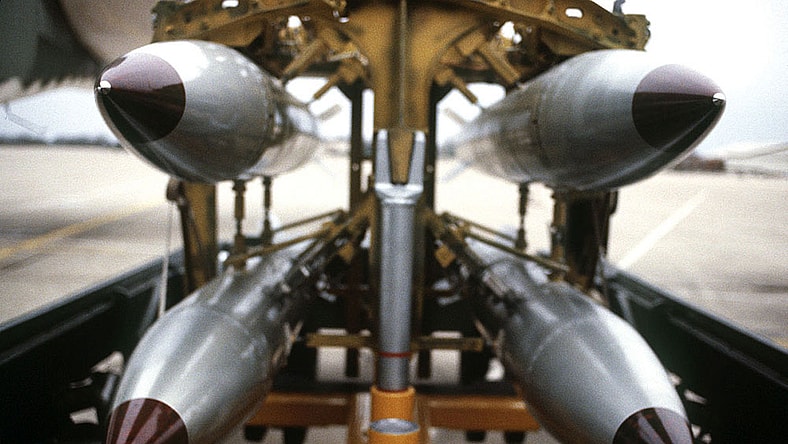Meet America’s Scary New Arsenal of Smaller, Deadlier Nuclear Weapons
These nukes are smaller, smarter and way more accurate.

The U.S. has reduced the size of its nuclear arsenal since the height of the Cold War, and also the size of some of its bombs. The newer, smaller nuclear warheads are more accurate and deadly as ever, and other nations aren’t very happy about it, reported the New York Times.
In the fall of 2015, when North Korea was busy prepping for what it would claim was a hydrogen bomb test in early 2016, the U.S. was conducting test runs in Nevada of what the Times termed its “first precision-guided atom bomb.”
The B-61 nuclear bomb has been in America’s arsenal since the 1960s. The version of the B-61 tested—sans actual nuclear bomb—in Nevada has been updated to near smart bomb status, according to the Times:
Its computer brain and four maneuverable fins let it zero in on deeply buried targets like testing tunnels and weapon sites. And its yield, the bomb’s explosive force, can be dialed up or down depending on the target, to minimize collateral damage.
While the Obama administration believes smaller, smarter bombs make sense in the 21st century, allowing for greater accuracy and perhaps stalling Cold War nightmare scenarios of mushroom clouds scouring cities from the landscape, there are critics in Washington who believe intelligent weapons like the B-61 Model 12 have their own drawbacks. For one thing, the bomb’s precision might make it more tempting to use—possibly even in a first strike scenario.
The Times quoted former Joint Chiefs of Staff vice chairman Gen. James E. Cartwright, who was in favor of the smaller and smarter approach. According to the General, these weapons promote keeping smaller amounts of nuclear weapons on hand. However, he did admit that “going smaller” tends to make “the weapon more thinkable.”
Reduced-size weapons with more intelligent designs appear to be the general direction of U.S. armament, and the NYT reported they will end up costing a trillion dollars over the next 30 years.
Neither Russia nor China are fans of America’s new nuclear efforts, the Russians calling B-61 tests in particular “provocative.” North Korea even cited America’s efforts as an excuse for pursuing a hydrogen bomb.
Another danger in small nuclear weapons, certainly in small, smart weapons with remotely controllable computer brains, might be seen in the snafu that recently parked an unarmed U.S. Hellfire Missile in Cuba—when that missile had been intended for NATO use in the E.U.
Nobody wants to think about the possibility of a rogue nuclear weapon easily concealed in the bed of a pickup truck, but if the greatest military in the world can lose track of a little old Hellfire, it’s easy to see how a much worse screw-up could happen one day.
Probably not, though. At least we would hope so.
